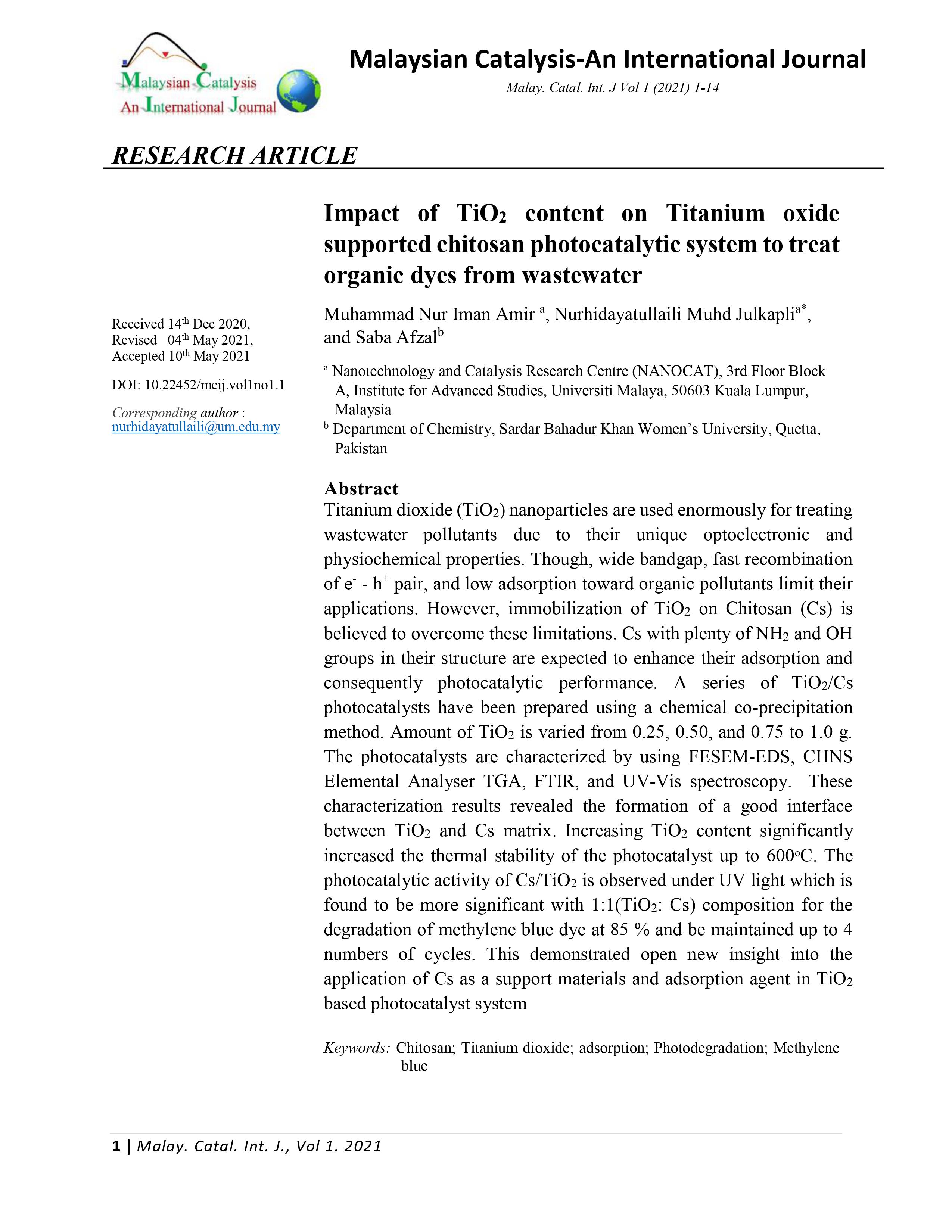Impact of TiO2 content on Titanium oxide supported chitosan photocatalytic system to treat organic dyes from wastewater
Keywords:
Chitosan; Titanium dioxide; adsorption; Photodegradation; Methylene blueAbstract
Titanium dioxide (TiO2) nanoparticles are used enormously for treating wastewater pollutants due to their unique optoelectronic and physiochemical properties. Though, wide bandgap, fast recombination of e- - h+ pair, and low adsorption toward organic pollutants limit their applications. However, immobilization of TiO2 on Chitosan (Cs) is believed to overcome these limitations. Cs with plenty of NH2 and OH groups in their structure are expected to enhance their adsorption and consequently photocatalytic performance. A series of TiO2/Cs photocatalysts have been prepared using a chemical co-precipitation method. Amount of TiO2 is varied from 0.25, 0.50, and 0.75 to 1.0 g. The photocatalysts are characterized by using FESEM-EDS, CHNS Elemental Analyser TGA, FTIR, and UV-Vis spectroscopy. These characterization results revealed the formation of a good interface between TiO2 and Cs matrix. Increasing TiO2 content significantly increased the thermal stability of the photocatalyst up to 600ᵒC. The photocatalytic activity of Cs/TiO2 is observed under UV light which is found to be more significant with 1:1(TiO2: Cs) composition for the degradation of methylene blue dye at 85 % and be maintained up to 4 numbers of cycles. This demonstrated open new insight into the application of Cs as a support materials and adsorption agent in TiO2 based photocatalyst system
Downloads
References
Z. Shayegan, C.S. Lee, F. Haghighat. TiO2 photocatalyst for removal of volatile organic compounds in gas phase–A review. Chem. Eng. J. 2018, 334, 2408-2439.
D. Gao, X. Wu, P. Wang, Y. Xu, H. Yu, J. Yu, Simultaneous realization of direct photoinduced deposition and improved H2-evolution performance of Sn-nanoparticle-modified TiO2 photocatalyst. ACS Sustain. Chem. Eng. 2019, 7(11), 10084-10094
H. Abdullah, M. M. R. Khan, H. R. Ong and Z. Yaakob. Modified TiO2 photocatalyst for CO2 photocatalytic reduction: an overview. J. CO2 Util. 2017, 22, 15-32.
Y. Yang, L. C. Yin, Y. Gong, P. Niu, J.Q. Wang, L. Gu, X. Chen, G. Liu, L. Wang, and H.M. Cheng. An unusual strong visible‐light absorption band in red anatase TiO2 photocatalyst induced by atomic hydrogen‐occupied oxygen vacancies. Adv. Mater, 2018, 30(6), 1704479
D. Gao, W. Liu, Y. Xu, P. Wang, J. Fan and H. Yu, Core-shell Ag@Ni cocatalyst on the TiO2 photocatalyst: one-step photoinduced deposition and its improved H2-evolution activity. Appl. Catal. B. 2020, 260, 118190.
M. S. F. A. Zamri, N. Sapawe Regeneration studies of TiO2 photocatalyst for degradation of phenol in a batch system. Mater. Today: Proc. 2019, 19, 1327-1332.
B.A Bhanvase, T.P. Shende, S.H. Sonawane. A review on graphene–TiO2 and doped graphene–TiO2 nanocomposite photocatalyst for water and wastewater treatment. Environ. Technol. Rev. 2017, 6(1), 1-14.
J. Hu, S. Zhang, Y. Cao, H. Wang, H. Yu, F. Peng Novel highly active anatase/rutile TiO2 photocatalyst with hydrogenated heterophase interface structures for photoelectrochemical water splitting into hydrogen. ACS Sustain. Chem. Eng, 2018, 6(8), 10823-10832.
K. Shoueir, S. Kandil, H. El-hosainy, M. El-Kemary. Tailoring the surface reactivity of plasmonic Au@TiO2 photocatalyst bio-based chitosan fiber towards cleaner of harmful water pollutants under visible-light irradiation. J. Clean. Prod. 2019, 230, 383-393.
K. Shirai, G. Fazio, T. Sugimoto, D. Selli, L. Ferraro, K. Watanabe, M. Haruta, B. Ohtani, H. Kurata, C. Di Valentin and Y. Matsumoto.,. Water-assisted hole trapping at the highly curved surface of nano-TiO2 photocatalyst. J. Am. Chem. Soc, 2018, 140(4),1415-1422.
M. Guo, W. Jiang, C. Chen, S. Qu, J. Lu, W. Yi and J. Ding. (2021). Process optimization of biodiesel production from waste cooking oil by esterification of free fatty acids using La3+/ZnO-TiO2 photocatalyst. Energy Convers. Manage. 2021, 229, 113745.
L. Yi, F. Lan, J. Li, C. Zhao, Efficient noble-metal-free Co-NG/TiO2 photocatalyst for H2 evolution: Synergistic effect between single-atom Co and N-doped graphene for enhanced photocatalytic activity. ACS Sustain. Chem. Eng. 2018, 6(10), 12766-12775.
A. Abdelhaleem, W. Chu, X. Liang, Diphenamid degradation via sulfite activation under visible LED using Fe (III) impregnated N-doped TiO2 photocatalyst. Appl. Catal. B. 2019, 244, 823-835.
F. Chen, P. Ho, R. Ran, W. Chen, Z. Si, X. Wu, D. Weng, Z. Huang and C. Lee, Synergistic effect of CeO2 modified TiO2 photocatalyst on the enhancement of visible light photocatalytic performance. J. Alloys Compd., 2017, 714, pp.560-566.
H. L. Yu, Q. X. Wu, J. Wang, L. Q. Liu, B. Zheng, C. Zhang, Y. G. Shen, C. L. Huang, B. Zhou and J. R. Jia. Simple fabrication of the Ag-Ag2O-TiO2 photocatalyst thin films on polyester fabrics by magnetron sputtering and its photocatalytic activity. Appl. Surf. Sci. 2020, 503, 144075
M. A. M. Adnan, B. L Phoon, N, N. M Julkapli. Mitigation of pollutants by chitosan /metallic oxide photocatalyst: a review. J. Clean. Prod. 2020, 261, 121190.
S. Zarei, N. Farhadian, R. Akbarzadeh, M. Pirsaheb, A. Asadi, Z. Safaei,. Fabrication of novel 2D Ag-TiO2/γ-Al2O3/Chitosan nanocomposite photocatalyst toward enhanced photocatalytic reduction of nitrate. Int. J. Biol. Macromol, 2020, 145, 926-935.
A. M. Saad, M. R. Abukhadra, S. Abdel-Kader Ahmed, A. M. Elzanaty, A. H. Mady, M. A. Betiha, J. J. Shim and A. M. Rabie. Photocatalytic degradation of malachite green dye using chitosan supported ZnO and Ce–ZnO nano-flowers under visible light. J. Environ. Manage. 2020, 258, .110043.
S. J. Shah, A. Khan, N. Naz, A. Ismail, M. Zahid, M. S. Khan, Awais, M. Ismail, S. u. H. Bakhtiar, I. Khan, B. Ahmad, N. Ali, A. Zada and S. Ali, Synthesis of CoCrFeO4-chitosan beads sun-light-driven photocatalyst with well recycling for efficiently degrading high-concentration dyes. Spectrochim Acta A. 2020, 236, 118314.
I. H. Tseng, Z. C. Liu, P. Y. Chang, Bio-friendly titania-grafted chitosan film with biomimetic surface structure for photocatalytic application. Carbohydr. Polym. 2020, 230, 115584.





